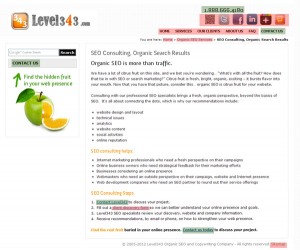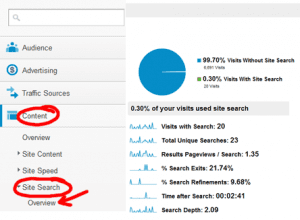Today, we’re diving into part 3 of our metric measurement info morsels, the Measuring Metrics series. It all began with a guest post we wrote Measuring Metrics for Success for SearchNewsCentral. When the team got together to brainstorm for the next bit of blogs, we realized that a lot more could be said about metrics, business funnels and market segmentation, especially when it comes to KPIs (Key Performance Indicators).
A Note on Systematic KPI Discovery
If you were to pull together all the data from your online marketing efforts, you’d be scratching your head in confusion very shortly. Why? Because it’s too much. You’ll come across three data types in your analytics travels:
- The important kind
- The kind that’s nice to have
- The filler that only data analysts and numbers freaks will enjoy pouring over although it really isn’t helpful
If you can’t learn how to distinguish them, you’ll quickly become overwhelmed. This is where KPIs come in.
Choosing KPIs is part training, part common sense and part intuition. It’s also having an understanding of what a Key Performance Indicator is, and what it is not. A KPI is a performance metric, but it is not just any performance metric or bit of measurable data. In online marketing, this important performance indicator helps us learn and improve upon our marketing efforts.
With all the data pouring in to your analytics, how can you narrow the choices? By asking yourself these questions:
- Is this information actually important to have? For example, it’s important to know 500 people visited your site from Poland last month. However, if you’re strictly located in a 300-mile radius from your home base, does it really matter what those people in Poland actually did on your site? Probably not. What matters is that you figure out why Poland is giving you better returns than the U.S., and how to change your campaign to compensate.
- What question are you trying to answer? One of the most frustrating things about KPIs for the non-initiated is the fact that they change depending on what you’re trying to find out. For example, would you track how successful a Facebook campaign was by looking at visits from search? No, because search and social are two different things.
- What goals are you trying to track? You can’t have a Key Performance Indicator if you don’t have something that you want to perform in the first place. You have to have a goal to know what questions to ask to know whether the information is important. It’s a vicious cycle of common sense that isn’t so common.
Why are we covering basics like these in the middle of the Measuring Metrics series? Because today, we’re moving on to stage 3, where the most data comes flooding in…
Engagement – Stage 3 of the Standard Business Funnel
“Engagement is a response that does not actively and directly affect the company’s business goals.”~ Measuring Metrics for Success
We used YouTube comments as an example in the above article, but the long of the short of it is this: if it isn’t the actual conversion, it’s engagement. Examples of the engagement stage could include:
- Clicking through the pages of your website
- Watching a video you posted on YouTube
- Commenting on your blog post
- Asking you a question on Twitter
Now, these are just examples that could change drastically depending on your goal. For example, if the business goal you’re trying to track is to have more people ask you questions on Twitter, then this action is a conversion, not engagement.
Market Segmentation and How It Applies
By the time you’ve reached this article in the series, we hope you have a better understanding of how market segmentation works in business and analytics. The sum of it is that each segment of your market (i.e. parents, single, married, significant others, engaged are all market segments) will have their own reasons for using your product. Because their reasoning differs, you may find yourself needing a range of marketing tactics in order to reach the widest audience array.
For example, a TV ad aimed at kids might be great on PSKids or DisneyTV, but you sure wouldn’t spend the marketing dollars to run it on ESPN, would you? No. As you segment your market into various demographics and created targeted campaigns for each demographic, you could very easily be tracking hundreds, if not thousands of metrics. Therefore, doesn’t it make sense to keep your tracking segmented?
Market segmentation helps you define which demographics perform better, but performance can’t be perceived by demographics alone. Non-performance could be the wrong audience, or it could be the wrong ad for the right audience. It could be a confusing business funnel after the ad. It could be the inability to find a “buy now” button on the website. There has to be more than demographics, there is more, and they’re called Key Performance Indicators.
Key Performance Indicators – What Metrics Do I Track?
You know your website best. You know what marketing strategies you have in the works. You know what your hoped for return is. To find your KPIs for the Engagement stage, you have to look at what you want to accomplish.
Let’s look at a single page as a very simplified example for a campaign (click on the image to the left and a larger version will open in a new window). Your entire campaign is geared towards pushing traffic to this page. You need to make sure your marketing dollars are doing what they’re supposed to do, right? Right. What do you want your dollars to do? Two things:
- Bring engagement and interaction with your consumer base for building brand recognition/brand activists
- Increase conversions in order to increase the company’s bottom line
Looking at the possible actions on this page, where are the conversions? Where are the opportunities for engagement or further interaction? Quite simply, we have one call to action. Contact us. We want you to click the link to our contact page or dial the number on your screen. That’s it. Anything else is either a) engagement/increased interaction with the company or b) falling out of the funnel.
Some of the actions available on this page, such as clicking on our social networks, are not immediately trackable through analytics. A little tweaking will need to be done using onClick event tracking. Google has an in depth guide on event tracking for Google Analytics, but if it reads too geeky for you there’s always the Idiot’s Guide to Event Tracking.
For this page, our KPIs would be segmented because, although we want conversions, we also want interaction:
KPI Segment 1: Interaction/Engagement (highlighted in red in the image)
- onClick events to Twitter, Facebook, LinkedIn, Google+ or our blog
- on page movement to one of our other menu items
- clicking on the discovery form link
- clicking on the sitemap link
- using the search function
KPI Segment 2: Conversion (highlighted in green in the image)
- Clicking on one of the contact us links
- Calling our number and talking to a representative
How To Use These Metrics
Data is only as good as the use you put it to. For example, it does you no good to know that 20 people used the search function. What does do you good is knowing why they used the search function. What were they looking for? (To find out, visit Content > Site Search > Overview. Take a look and then dig deeper into Search Term and so on. )
Another example is the sitemap link. When people click on the sitemap, what you’re really seeing is a confused visitor. This number isn’t so much a metric of success as it is an indication of confusion on the visitor’s part. The page is not performing in the best way possible to move the visitor further down the business funnel.
Remember the True Purpose of the KPI
The job of a Key Performance Indicator is to point out areas that need improvement. If you have 430 visitors hit your home page and a steady 50% drop off for each click after that, you can’t afford too many clicks, can you? By the time the visitors are 4 clicks deep, you only have 26 left! –And, those 26 visitors still have to finish the buy now or contact us process, don’t they?
Here’s the deal. If this is happening to you and you aren’t tracking anything, all you know is that you have a marketing bucket full of holes. You can shove a ton of money into the bucket, but unless you fill the holes it’ll all leak out. If we worked like that our clients would quickly run the other way, and rightly so.
If you are tracking, but you aren’t segmenting, you’ll have a bunch of data piled up in the big old laundry basket of analytics. Unless you take each piece out and look it over, you’ll never know what all is in that basket. If you’re segmenting, but you aren’t tracking the right KPIs, you may very well be tweaking the wrong things, or tossing successful campaigns because they looked like they were crashing.
Correct KPI tracking will give you the ability to dig into each step of the failing process and pinpoint where it’s failing. In other words, it provides smart management for your marketing efforts. It provides a birds-eye view as well as an in depth view of how well your business funnel is working, every stage of the way.
What You May Have Missed
Part 1: Measuring Awareness with Careful KPIs: An Info-Morsel on Metrics
Part 2: Acquisition and the KPIs to Track It: Metric Measuring Part Deux
We hope you’re enjoying our series on Measuring Metrics, and we hope to see you back next week. Monday we’ll be talking about conversion tracking, and Thursday we’ll tie it all together for you. Don’t miss the final blog of the Measuring Metrics for Success Series, where we’ll be offering the whole bit in a handy eBook for easy reading. Until then, give us a call and let’s discuss how can we help you get more of it?!










































2 Responses
Great concepts found here for all of us noob internet marketing types
A good article to explain all things at the same time.most of the points are very useful.
Thanks for sharing this information about KPI.